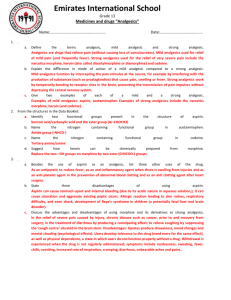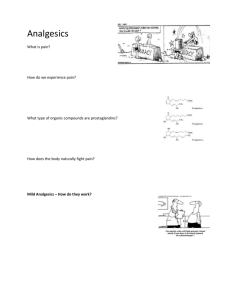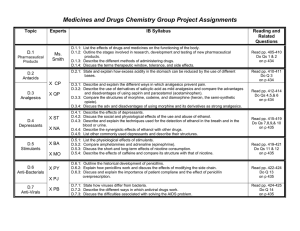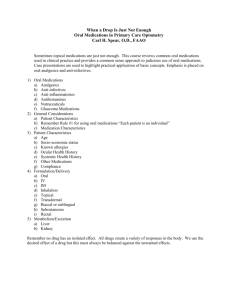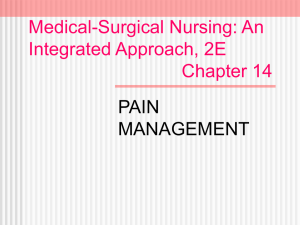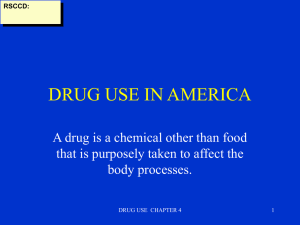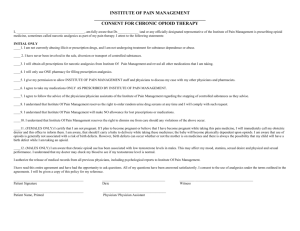Document 13308913
advertisement
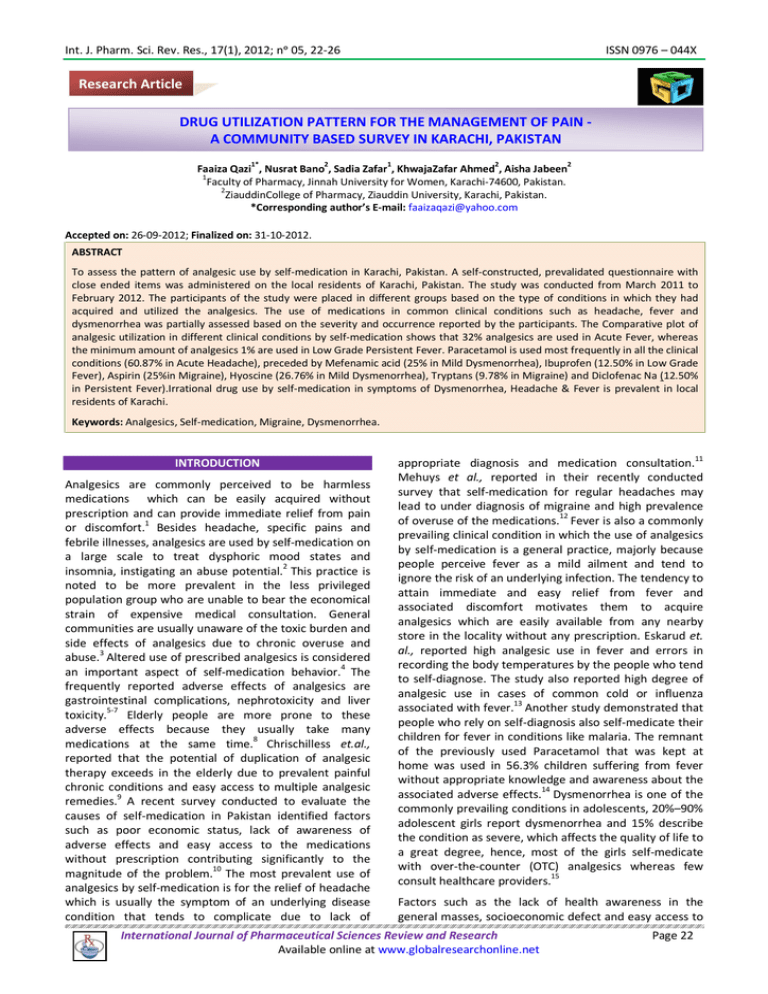
Int. J. Pharm. Sci. Rev. Res., 17(1), 2012; nᵒ 05, 22-26 ISSN 0976 – 044X Research Article DRUG UTILIZATION PATTERN FOR THE MANAGEMENT OF PAIN A COMMUNITY BASED SURVEY IN KARACHI, PAKISTAN 1* 2 1 2 2 Faaiza Qazi , Nusrat Bano , Sadia Zafar , KhwajaZafar Ahmed , Aisha Jabeen 1 Faculty of Pharmacy, Jinnah University for Women, Karachi-74600, Pakistan. 2 ZiauddinCollege of Pharmacy, Ziauddin University, Karachi, Pakistan. *Corresponding author’s E-mail: faaizaqazi@yahoo.com Accepted on: 26-09-2012; Finalized on: 31-10-2012. ABSTRACT To assess the pattern of analgesic use by self-medication in Karachi, Pakistan. A self-constructed, prevalidated questionnaire with close ended items was administered on the local residents of Karachi, Pakistan. The study was conducted from March 2011 to February 2012. The participants of the study were placed in different groups based on the type of conditions in which they had acquired and utilized the analgesics. The use of medications in common clinical conditions such as headache, fever and dysmenorrhea was partially assessed based on the severity and occurrence reported by the participants. The Comparative plot of analgesic utilization in different clinical conditions by self-medication shows that 32% analgesics are used in Acute Fever, whereas the minimum amount of analgesics 1% are used in Low Grade Persistent Fever. Paracetamol is used most frequently in all the clinical conditions (60.87% in Acute Headache), preceded by Mefenamic acid (25% in Mild Dysmenorrhea), Ibuprofen (12.50% in Low Grade Fever), Aspirin (25%in Migraine), Hyoscine (26.76% in Mild Dysmenorrhea), Tryptans (9.78% in Migraine) and Diclofenac Na (12.50% in Persistent Fever).Irrational drug use by self-medication in symptoms of Dysmenorrhea, Headache & Fever is prevalent in local residents of Karachi. Keywords: Analgesics, Self-medication, Migraine, Dysmenorrhea. INTRODUCTION Analgesics are commonly perceived to be harmless medications which can be easily acquired without prescription and can provide immediate relief from pain or discomfort.1 Besides headache, specific pains and febrile illnesses, analgesics are used by self-medication on a large scale to treat dysphoric mood states and insomnia, instigating an abuse potential.2 This practice is noted to be more prevalent in the less privileged population group who are unable to bear the economical strain of expensive medical consultation. General communities are usually unaware of the toxic burden and side effects of analgesics due to chronic overuse and abuse.3 Altered use of prescribed analgesics is considered an important aspect of self-medication behavior.4 The frequently reported adverse effects of analgesics are gastrointestinal complications, nephrotoxicity and liver 5-7 toxicity. Elderly people are more prone to these adverse effects because they usually take many medications at the same time.8 Chrischilless et.al., reported that the potential of duplication of analgesic therapy exceeds in the elderly due to prevalent painful chronic conditions and easy access to multiple analgesic remedies.9 A recent survey conducted to evaluate the causes of self-medication in Pakistan identified factors such as poor economic status, lack of awareness of adverse effects and easy access to the medications without prescription contributing significantly to the 10 magnitude of the problem. The most prevalent use of analgesics by self-medication is for the relief of headache which is usually the symptom of an underlying disease condition that tends to complicate due to lack of appropriate diagnosis and medication consultation.11 Mehuys et al., reported in their recently conducted survey that self-medication for regular headaches may lead to under diagnosis of migraine and high prevalence of overuse of the medications.12 Fever is also a commonly prevailing clinical condition in which the use of analgesics by self-medication is a general practice, majorly because people perceive fever as a mild ailment and tend to ignore the risk of an underlying infection. The tendency to attain immediate and easy relief from fever and associated discomfort motivates them to acquire analgesics which are easily available from any nearby store in the locality without any prescription. Eskarud et. al., reported high analgesic use in fever and errors in recording the body temperatures by the people who tend to self-diagnose. The study also reported high degree of analgesic use in cases of common cold or influenza 13 associated with fever. Another study demonstrated that people who rely on self-diagnosis also self-medicate their children for fever in conditions like malaria. The remnant of the previously used Paracetamol that was kept at home was used in 56.3% children suffering from fever without appropriate knowledge and awareness about the associated adverse effects.14 Dysmenorrhea is one of the commonly prevailing conditions in adolescents, 20%–90% adolescent girls report dysmenorrhea and 15% describe the condition as severe, which affects the quality of life to a great degree, hence, most of the girls self-medicate with over-the-counter (OTC) analgesics whereas few 15 consult healthcare providers. Factors such as the lack of health awareness in the general masses, socioeconomic defect and easy access to International Journal of Pharmaceutical Sciences Review and Research Available online at www.globalresearchonline.net Page 22 Int. J. Pharm. Sci. Rev. Res., 17(1), 2012; nᵒ 05, 22-26 analgesics which are readily available over the counter in local dispensaries and medical stores contribute to the magnitude of the problem of self-medication. MATERIALS AND METHODS A descriptive cross sectional study designed to assess the magnitude and the comparative aspects for the practice of self-medication of analgesics was conducted in the local residents of Karachi from March 2011 to Feb 2012. The survey was conducted by 100 fifth year Pharm.D students selected from two private general Universities. The students were well aware of the rationale of study and voluntarily participated to conduct the study in an attempt to gain knowledge and generate awareness. They were informed about the ethical considerations and method to administer the survey. ‘Convenient contact list’ by each student in alphabetical order was devised containing 30 people each e.g. school fellows, family friends, neighbors, relatives and domestic help (to attain heterogeneous characteristics of local residents of Karachi). Fifteen people were selected from the ‘convenient contact list’ by random sampling. 1500 local residents of Karachi, hence selected were contacted in the process at their workplaces, educational institutes and residential areas. Among the total number of contacted people 1380 individuals comprising of mean age 34.45 +7.54 were accessible and evaluable. A pre validated questionnaire (n=35), devised from similar studies, comprising of close ended items was administered to the subjects to be filled anonymously following informed consent and the purpose of the study. Cronbach’s alpha value of the questionnaire was 0.87. Factor analysis was used for the construct validity. Internal consistency tests were used to evaluate the questionnaires reliability. Spearman brown coefficient was 0.76 for the whole questionnaire. The questionnaire was in the native language Urdu. For the participants of the study who were unable to read the questionnaire and apprehend it, the questions were spoken out loud, clarity of concept was confirmed and the answers were reconfirmed and entered into the questionnaire by the investigator. They were investigated about the use of analgesics in any of the disease conditions described in the survey the choice of analgesics and the disease conditions in which they had used that drug without consulting any doctor or medical officer in the recent past. The demographic details, treatment choice, attitude and the relevant tendency of self-medication were carefully taken into account and hence categorized. The individuals were encouraged to show the used pack of medicine that they have utilized in the above stated context, which elucidated 54% positive feedback response (mostly from the residents of the slum areas of Karachi). Data was analyzed by SPSS version 19 and results were expressed in counts and percentages. ISSN 0976 – 044X RESULTS Out of the 1500 planned samples, 30 refused to participate and 90 incomplete questionnaires were excluded. Therefore, 1380 subjects completed the survey. The 1380 study participants were local Karachi residents, about 743 were males (53.8%) and 637 were females (46.2%). The mean age of the study population was 34.45 +7.54 years. The study sample included 2.2% upper middle class, 8.3% Middle class, 14.5% lower middle class, 18.8% skilled working class, 25% working class and 31.2% lowest level of subsistence. About 18.7% of the respondents were educated, 34.1% were having basic primary education while 47.2% were uneducated. Based on the place of contact for the study participants, 32.6% were contacted in Educational Institutes, 45.7% were contacted in work places and 21.7% were contacted in residential areas. The demographics of the study population are presented in Table 1. Table 1: General baseline characteristics of the study population (n=1380) Characteristics Gender Male Female Age (Years) 15 – 35 Respondents N % 743 637 53.84 46.16 198 14.35 36 – 55 56 -75 Socio-Economic Status* Upper Middle Class (A) Middle Class (B) 975 207 70.65 15.00 30 115 2.17 8.33 Lower Middle Class (C1) Skilled Working Class (C2) Working Class (D) Those Of Lowest Level Of Subsistence Education Level 200 260 345 430 14.49 18.84 25.00 31.16 Educated Basic Primary Education Uneducated Place of contact for study Educational Institute 258 470 652 18.70 34.06 47.25 450 32.61 Work Place Residential Area *Adapted from NRS social grades. 630 300 45.65 21.74 Among the study subjects 56.2% participants acquired analgesics from local stores, whereas, 30.8% from licensed Pharmacy. Most of the participants (71.5%) purchased few dosage forms without leaflets while only 8.7% participants purchased few dosage forms with leaflets. The study finding showed that only 11.4% respondents were completely aware of the adverse effect of analgesics, however, majority of the participants (69.1%) were unaware of the adverse effect of analgesics. Response of participants in terms of acquiring, purchasing International Journal of Pharmaceutical Sciences Review and Research Available online at www.globalresearchonline.net Page 23 Int. J. Pharm. Sci. Rev. Res., 17(1), 2012; nᵒ 05, 22-26 and awareness of adverse effect of analgesics are presented in Table 2. Table 2: Drug utilization features of the respondents (n=1380) Respondents N % Parameters Analgesics acquired from Licensed Pharmacy Local Store Borrowed 425 775 180 30.80 56.16 13.04 Amount Purchased Whole Pack With Leaflet Few Dosage Forms With Leaflet Few Dosage Forms Without Leaflet Awareness of Adverse Effect 273 120 987 19.78 8.70 71.52 Complete Limited None 157 270 953 11.38 19.57 69.06 ISSN 0976 – 044X The pattern of analgesic use by self-medication in six clinical conditions is shown in Table3. The comparative plot of analgesics in different clinical conditions by selfmedication (Fig 1) shows highest consumption (32%) in Acute fever, 27% in Acute Headache, 24% in Mild dysmenorrhea, 9% in Severe dysmenorrhea, 7% in Migraine whereas the lowest consumption (1%) in Low Grade Persistent Fever. The cumulative % utilization of each type of analgesic is shown in Fig.2 indicating that Paracetamol is the most widely used analgesic in all of the clinical conditions, preceded by Mefenamic acid (25% in Mild Dysmenorrhea) and Ibuprofen (12.50% in Low Grade Fever). The use of Hyoscine and Herbal drugs by selfmedication is only observed in Mild Dysmenorrhea (Hyoscine 26.8%) and Severe Dysmenorrhea (Herbal drugs 43.3%). Tryptans/Tramadol is utilized by selfmedication in Acute Headache (8.2%) and Migraine (9.8%), whereas, Diclofenac Na is utilized by selfmedication in fever (Acute 5.9%, low grade persistent 12.5%) only. Table 3: Pattern of analgesic use in different groups of clinical conditions DISCUSSION Figure 1: Comparative plot of analgesic utilization in different clinical conditions Figure 2: Type and frequency of analgesic used in different clinical conditions by self-medication. Responsible self-medication based on appropriate knowledge of doses and adverse effects is beneficial for an individual in some self-recognizable chronic and recurrent conditions imparting sensible self-reliance.16 Self-medication with analgesics is common and accepted and even recommended by health care systems in order to avoid reimbursement. Self-medication, nevertheless, is not an easy task, since making choices is difficult for patients on the basis of the available standard information.17 The labels of the OTC analgesics carry directions, warning about exceeding the doses chronic abuse and hazards owing to such practice and advising the patient to stop the drug use and seek medical help if pain or fever worsens or persists.18 However the dilemma is that, the analgesics are provided to most of the people (71.52%) of the local residents without labels or leaflets from local stores and dispensaries in Karachi. These people usually buy one or two tablets/capsules at a time to avoid the cost of the whole pack. It is a usual practice that the person dispensing the medication in the local store or the dispensaries cuts a portion of the blister package to hand over few tablets /capsules without giving any information about the adverse effects, dosing regimen or even the expiry dates. Such a malpractice International Journal of Pharmaceutical Sciences Review and Research Available online at www.globalresearchonline.net Page 24 Int. J. Pharm. Sci. Rev. Res., 17(1), 2012; nᵒ 05, 22-26 leads to the risk of greater hazard to the consumers of analgesics depriving them of the basic knowledge (e.g. Expiry Date, Contraindications, and Dose) about the medicines consumed by them. A large number of participants who utilized analgesics by self-medication (47.25%) are unable to read the labels and interpret the dosing instructions and other details and it is necessary that the medication and its appropriate use should be explained to them by a licensed and trained pharmacist. Our study however, shows that only 30.80% people purchased the analgesics from licensed Pharmacists who were able to guide them about the correct doses or probable interactions, whereas 56.16% people purchased the medications from local stores which may also generally provide grocery or dairy products to the local residents. No licensed Pharmacist is available in such stores. About 13.04% participants acquired the medications from friends, acquaintances, colleagues or family who tend to store analgesics in their handbags or drawers at work or homes, along with a word of advice on the dose and dosing schedule that worked for them. Paracetamol is the most frequently used drug as shown in our study (Fig. 2). Only few people who reported the use of Paracetamol during our study were completely aware of the adverse effect profile of the medication (11.38%). Hepatotoxicity due to the use of Paracetamol even in therapeutic doses with different risk factors has also been reported.20Because of the risk of hepatic toxicity due to the chronic use of Paracetamol it is recommended that the conditions of the patients receiving long-term full doses of either Aspirin or Paracetamol should be intermittently monitored for hepatic injury.21 It was commonly observed during the conduct of this study that most of the people who utilize Paracetamol by selfmedication (often on chronic basis) do not consider screening of their hepatic profile as they are completely unaware (69.06%) or incompletely aware (19.57%) about the risk of hepatotoxicity and other adverse effects, to which they are greatly prone. This study shows that analgesics are widely used in acute headache (32%) and migraine (7%). A recent survey to evaluate the irrational drug use in Pakistan has reported “the use of Paracetamol plus caffeine on daily basis to alleviate the symptoms of fatigue and lethargy along with dull constant headache that might hinder studies and daily routine. It is a rather alarming situation that Paracetamol is used to “refresh” probably like a cup of tea”22 Migraine and chronic recurrent headaches are reported to be a major reason for self-medication of 23 analgesics. A previous study also shows that it is perceived by many patients that self-medication with OTC analgesic for treatment of migraine is more effective than physician prescribed medicines, and hence they usually withdraw from the use of the medicines prescribed by the physician and start the use of OTC drugs by self24 medication. A large number of female participants in the study reported the use of analgesics for the treatment of menstrual related pains such as headache or ISSN 0976 – 044X dysmenorrhea which alter their performance and general status. The use of analgesics for the management of menstrual pain is also reported in earlier studies.25,26 Although the pathogenesis of menstrual-related pain conditions is not fully understood, menstrual-related overproduction of prostaglandins is implicated in the pathophysiology of both menstrual migraine and dysmenorrhea. In clinical practice, Non-steroidal antiinflammatory drugs (NSAIDs) are considered the first-line therapeutic option for treating pain associated with dysmenorrhea. NSAIDs also play a role in the acute treatment and intermittent prophylaxis of migraine.27 Hence the use of analgesics by self-medication for such conditions is both effective and therapeutic, thus improving the quality of life impaired by the clinical condition in the female adolescents. An interesting study reported the inclination of females towards selfmedication of analgesics is due to the female characters in drug advertisements who are frequently portrayed in these commercials as experts on home medical care, often as mothers caring for ill children.28 As discussed before, the benefits of sensible self-medication of analgesics cannot be overruled, however, the dire circumstances reported in this study indicate that prompt strategies should be designed and implemented to install effective pharmacovigilance in the health care system in order to regulate the appropriate use of medications in the community. Community Pharmacy practice should be initiated and regulated properly to impart awareness and education for sensible self-medication of analgesics and other OTC medications. CONCLUSION Irrational analgesic use prevails in the community in the absence of adequate and convenient healthcare facilities which are currently unable to cater the needs of the population. The community pharmacists should actively and effectively contribute towards imparting the basic knowledge to the local communities about the rational use of medicines and the associated risks of selfmedication in certain conditions requiring prompt medical attention. Awareness about the potential hazard of drug use on such frequent basis and large scale should be generated. Parameters endorsing effective pharmacovigilance should be immediately brought to effect. Acknowledgement: Parts of this manuscript have been presented (poster presentation) at the Annual Symposium, Ziauddin University 2012, 28th April, Karachi, Pakistan. REFERENCES 1. Kaufman DW, Kelly JP, Rosenberg L, Anderson TE, Mitchell AA, Recent patterns of medication use in the ambulatory adult population of the United States. The Slone Survey, JAMA, 287(3), 2002, 337-44. 2. Abbott FV, Fraser MI, Use and abuse of over-the-counter analgesic agents,J Psychiatry Neurosci, 231(1), 1998, 13–34. International Journal of Pharmaceutical Sciences Review and Research Available online at www.globalresearchonline.net Page 25 Int. J. Pharm. Sci. Rev. Res., 17(1), 2012; nᵒ 05, 22-26 3. Cham E, Hall L, Ernst AA, Weiss SJ, Awareness and use of over-thecounter pain medications: a survey of emergency department patients, South Med J, 95(5), 2002, 529-535. 4. Segall A, A community survey of self-medication activities, Med Care, 28(4), 1990, 301–310. 5. Lanza FL, Endoscopic studies of gastric and duodenal injury after the use of ibuprofen, aspirin, and other nonsteroidal anti-inflammatory agents, Am J Med,77(1A), 1984, 19–24. 6. Gault MH, Wilson DR, Analgesic nephropathy in Canada: clinical syndrome, management, and outcome, Kidney Int, 13(1), 1978, 58– 63. 7. Barker JD Jr, de Carle DJ, Anuras S, Chronic excessive acetaminophen use and liver damage, Ann Intern Med, 87(3), 1977, 299–301. 8. Holden MD,Over-the-counter medications. Do you know what your patients are taking? Postgrad Med, 91(8), 1992, 191-194, 199-200. 9. Chrischilles EA, Lemke JH, Wallace RB, Drube GA, Prevalence and characteristics of multiple analgesic drug use in an elderly study group, J Am GeriatrSoc, 38(9): 1990, 979–984. ISSN 0976 – 044X 16. World Health Organization, Geneva, The role of the pharmacist in th self-care and self-medication, Report of the 4 WHO Consultative Group on the Role of the Pharmacist, The Hague, The Netherlands:26–28 August 1998, WHO/DAP/98.13. 17. Fox JM, Use of analgesics inself-medication,Therapie, 57(2), 2002, 115-8. 18. Pray WS, Recommending analgesics for common conditions, US Pharm, 34(5), 2009, 12-15. 19. Basara LR, Juergens JP, Patient package insert readability and design, Am Pharm, NS34(8), 1994, 48–53. 20. Andrade RJ, Lucena MI, Fernández-Sánchez MC, Peláez G, Hepatotoxicity caused by paracetamol at therapeutic doses, Med Clin (Barc), 109(8), 1997, 317-8. 21. Zimmerman HJ, Effects of Aspirin and Acetaminophen on the Liver, Arch Intern Med, 141(3), 1981, 333-342. 22. Bano N, Najam R, Qazi F, Irrational drug use based on selfmedication for some common clinicalconditions in an educated population of Karachi, Pak J Med Sci, 28(3), 2012, 359-362. 10. Bano N, Najam R, Qazi F, Naeem S, Assessment of self-medication in female university students of Pharmacy and Medicine-A prevalence study, Med Forum, 23(1), 2012, 47-51. 23. Edmeads J, Findlay H, Tugwell P, Pryse-Phillips W, Nelson RF, Murray TJ, Impact of migraine and tension-type headache on life-style, consulting behaviour, and medication use: a Canadian population survey, Can J NeurolSci, 20(2), 1993, 131–137. 11. Mathew NT, Chronic refractory headache, Neurology, 43(6 Suppl 3), 1993, S26–S33. 24. Robinson RG, Pain Relief for Headaches. Is self-medication a problem? Can Fam Physician, 39, 1993, 867-868,871-872. 12. Mehuys E, Paemeleire K, Van Hees T, Christiaens T, Van Bortel LM, Van Tongelen I, De Bolle L, Remon J-P, Boussery K, Self-medication of regular headache: a community pharmacy-based survey, Eur J Neurol, 19(8), 2012, 1093-1099. 25. Cheng HF, Lin YH, Selection and efficacy of self-management strategies for dysmenorrhea in young Taiwanese women, J ClinNurs, 20(7-8), 2011, 1018-1025. 13. Eskerud JR, Hoftvedt BO, Laerum E,Fever: Management and selfmedication. Results from a Norwegian population study,FamPract, 8(2), 1991, 148-153. 14. Oshikoya KA, Senbanjo IO, Fever in children: Mothers perceptions and their home management, Iran J Pediatr, 18(3), 2008, 229-36. 26. Jones AE, Managing the pain of primary and secondary dysmenorrhea, Nurs Times, 100(10), 2004, 40-43. 27. Mannix LK, Menstrual-Related Pain Conditions: Dysmenorrhea and Migraine, J Women's Health, 17(5), 2008, 879-891. 28. Craig RS, Women as home caregivers: gender portrayal in OTC drug commercials, J Drug Educ, 22(4), 1992, 303–312. 15. Davis AR, Westhoff CL, Primary dysmenorrhea in adolescent girls and treatment with oral contraceptives, J PediatrAdolescGynecol, 14(1), 2001, 3-8. ************************ International Journal of Pharmaceutical Sciences Review and Research Available online at www.globalresearchonline.net Page 26

